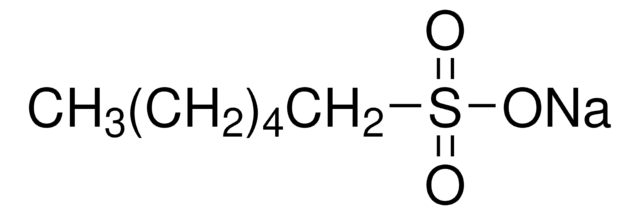13-1875
Hydrofluoric acid
JIS special grade
Synonym(s):
HF
About This Item
Recommended Products
grade
JIS special grade
vapor density
1.27 (vs air)
vapor pressure
25 mmHg ( 20 °C)
form
liquid
availability
available only in Japan
density
1.15 g/mL at 25 °C (lit.)
SMILES string
[H+].[F-]
InChI
1S/FH/h1H
InChI key
KRHYYFGTRYWZRS-UHFFFAOYSA-N
Looking for similar products? Visit Product Comparison Guide
Application
- Speciation of tin ions in oxide glass containing iron oxide through solvent extraction and inductively coupled plasma atomic emission spectrometry after the decomposition utilizing ascorbic acid.: This study explores the speciation of tin ions in oxide glass, enhanced by hydrofluoric acid in the decomposition process for analytical purposes ( Saijo et al., 2022).
- Physicochemical and morphological characterization of a glass ceramic treated with different ceramic primers and post-silanization protocols.: This research discusses the use of hydrofluoric acid in preparing glass ceramic surfaces to enhance their physicochemical properties for dental applications ( Moreno et al., 2019).
- Chemical analysis of acidic silicon etch solutions I. Titrimetric determination of HNO(3), HF, and H(2)SiF(6).: This paper details a method for analyzing hydrofluoric acid concentrations in industrial etching solutions, providing critical insights into its effective use in silicon processing ( Henßge et al., 2007).
- Structure of a novel phosphoglycolipid from Deinococcus radiodurans.: Hydrofluoric acid was utilized in the extraction processes that led to identifying unique phosphoglycolipids, contributing to biochemical research and applications ( Jürgens et al., 1986).
Signal Word
Danger
Hazard Statements
Precautionary Statements
Hazard Classifications
Acute Tox. 1 Dermal - Acute Tox. 2 Inhalation - Acute Tox. 2 Oral - Eye Dam. 1 - Skin Corr. 1A
Storage Class Code
6.1B - Non-combustible acute toxic Cat. 1 and 2 / very toxic hazardous materials
WGK
WGK 2
Flash Point(F)
Not applicable
Flash Point(C)
Not applicable
Regulatory Listings
Regulatory Listings are mainly provided for chemical products. Only limited information can be provided here for non-chemical products. No entry means none of the components are listed. It is the user’s obligation to ensure the safe and legal use of the product.
PDSCL
Poisonous substance
PRTR
Class I Designated Chemical Substances
ISHL Indicated Name
Substances Subject to be Indicated Names
ISHL Notified Names
Substances Subject to be Notified Names
JAN Code
13-1875-5-500G-J:
Choose from one of the most recent versions:
Already Own This Product?
Find documentation for the products that you have recently purchased in the Document Library.
Our team of scientists has experience in all areas of research including Life Science, Material Science, Chemical Synthesis, Chromatography, Analytical and many others.
Contact Technical Service









